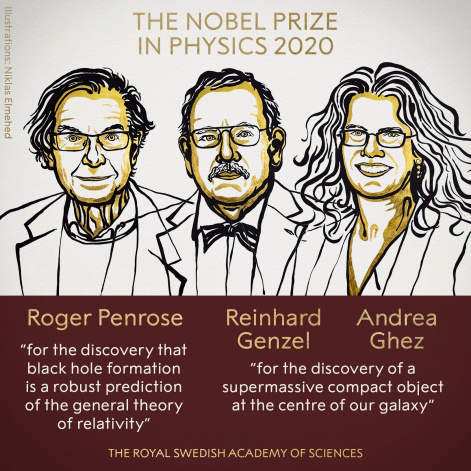Krasnoyarsk scientists about the Nobel Prize 2020: physics
7 October 2020 г.

Doctor in Physics and Mathematics, leading researcher at the L.V. Kirensky Institute of Physics FRC KSC SB RAS, Sergey Karpov, gives comments on the discovery awarded the Nobel Prize in Physics this year.
What discovery was awarded the Nobel Prize in physics?
The Nobel Prize in Physics this year was given for two discoveries. The first laureate was Roger Penrose, who proved that the formation of black holes is a robust prediction of the general theory of relativity. The second half of the award went to Reinhard Genzel and Andrea Ghez for the discovery of a supermassive compact object - a black hole - at the center of our galaxy.
Black holes, predicted at the beginning of the twentieth century, until recently were the object of only theoretical studies. The discovery of this year's Nobel laureates is based on one of the most brilliant scientific works of the XX century, published in 1915 by Albert Einstein - General theory of relativity (GR), which is, in fact, the theory of gravity. It was on the basis of the ideas outlined by Einstein that assumptions were made about the possibility of the existence of black holes.
As early as in 1916, the German physicist Karl Schwarzschild described the gravitational field created by the spherically symmetric mass distribution while solving the equations of general relativity. This solution included the gravitational radius of the body, determining the size of an object with a spherically symmetric distribution of matter, which even photons cannot escape from.
In 1965, a British physicist Roger Penrose published an article entitled "Gravitational Collapse and Space-Time Singularities." This work served as the basis for the beginning of the search for black holes by experimental methods.
The development of instrumental research methods, creation of a new generation of giant telescopes and ultrasensitive panoramic photo-recording devices, which allow obtaining images not only in the visible, but also in the infrared range of the spectrum, provided possibilities for looking into the center of our galaxy, which had previously been inaccessible for observation due to dense clouds of cosmic dust concentrating in this area.
About ten years ago, astrophysicists Reinhard Genzel from Germany and Andrea Ghez from the United States discovered giant stars in the center of our galaxy, with incredibly fast orbital rotation around an invisible object. This became an indirect confirmation of the gigantic mass of the central body. It could be nothing but a black hole.
What is the significance of these discoveries for a layman?
This is fundamental research which enriches our understanding of the world around us, in this case, deep space. For the world to be predictable and safe, it must be explored. The instinct of self-preservation lies at the heart of the human desire to know the world around him and a sense of curiosity. Humanity must know what the future holds and find ways to survive in the case of negative scenarios.
The scientific results of the current Nobel laureates open new horizons in the study of compact and supermassive space objects. This is just one of the stages of scientific research for scientists to find answers to numerous questions. We are talking not only about the experimental verification of general relativity in extreme conditions near a black hole, but also about assessing the degree of danger of these objects, since they are dispersed throughout the galaxy, and not only in its center.
Share:
